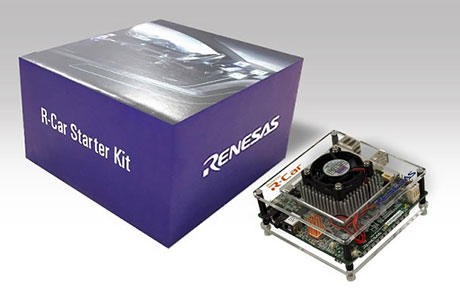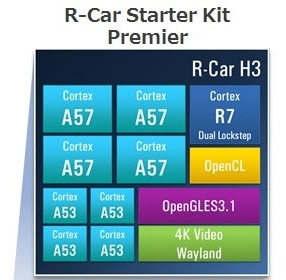Renesas R-Car H3ULCB¶
Overview¶
The H3 Starter Kit board is designed for evaluating the features and performance of the R-CAR H3 device from Renesas Electronics and it is also used for developing and evaluating application software for these R-CAR H3.
The H3 Starter Kit, based on the R-CAR H3 SIP, comes with LPDDR4 @4GB in 2-channel, each 64-bit wide+Hyperflash @64MB, CSI2 interfaces and several communication interfaces like USB, Ethernet, HDMI and can work standalone or can be adapted to other boards, via 440pin connector on bottom side.
It is possible to order 2 different types of H3 Starter Kit Boards, one with Ethernet connection onboard and one with Ethernet connection on ComExpress.
Note
The H3ULCB board can be plugged on a Renesas Kingfisher Infotainment daughter board through COM Express connector in order to physically access more I/O. CAUTION : In this case, power supply is managed by the daughter board.
More information about the board can be found at Renesas R-Car Starter Kit website.
Hardware¶
Hardware capabilities for the H3ULCB for can be found on the eLinux H3SK page of the board.
Note
Zephyr will be booted on the CR7 processor provided for RTOS purpose.
More information about the SoC that equips the board can be found here :
Supported Features¶
Here is the current supported features when running Zephyr Project on the R-Car ULCB CR7:
Interface |
Driver/components |
Support level |
|---|---|---|
PINMUX |
pinmux |
|
CLOCK |
clock_control |
|
GPIO |
gpio |
|
UART |
uart |
serial port-polling |
It’s also currently possible to write on the ram console.
More features will be supported soon.
Connections and IOs¶
H3ULCB Board :¶
Here are official IOs figures from eLinux for H3ULCB board :
Kingfisher Infotainment daughter board :¶
When connected to Kingfisher Infotainment board through COMExpress connector, the board is exposing much more IOs.
Here are official IOs figures from eLinux for Kingfisher Infotainment board :
GPIO :¶
By running Zephyr on H3ULCB, the software readable push button ‘SW3’ can be used as input, and the software contollable LED ‘LED5’ can be used as output.
UART :¶
H3ULCB board is providing two serial ports, only one is commonly available on the board, however, the second one can be made available either by welding components or by plugging the board on a Kingfisher Infotainment daughter board.
Here is information about these serial ports :
Physical Interface |
Physical Location |
Software Interface |
Converter |
Further Information |
|---|---|---|---|---|
CN12 DEBUG SERIAL |
ULCB Board |
SCIF2 |
FT232RQ |
Used by U-BOOT & Linux |
CN10 DEBUG SERIAL |
ULCB Board |
SCIF1 |
CP2102 |
Non-welded |
CN04 DEBUG SERIAL |
Kingfisher |
SCIF1 |
Secondary UART // Through ComExpress |
Note
The Zephyr console output is assigned to SCIF1 (commonly used on Kingfisher daughter board) with settings 115200 8N1 without hardware flow control by default.
Here is CN04 UART interface pinout (depending on your Kingfisher board version) :
Signal |
Pin KF03 |
Pin KF04 |
|---|---|---|
RXD |
3 |
4 |
TXD |
5 |
2 |
RTS |
4 |
1 |
CTS |
6 |
3 |
GND |
9 |
6 |
Programming and Debugging¶
The Cortex®-R7 of rcar_h3ulcb board needs to be started by the Cortex®-A cores. Cortex®-A cores are responsible to load the Cortex®-R7 binary application into the RAM, and get the Cortex®-R7 out of reset. The Cortex®-A can currently perform these steps at bootloader level.
Building¶
Applications for the rcar_h3ulcb_cr7 board configuration can be built in the usual way (see Building an Application for more details).
# From the root of the zephyr repository
west build -b rcar_h3ulcb_cr7 samples/hello_world
Debugging¶
You can debug an application using OpenOCD and GDB. The Solution proposed below is using a OpenOCD custom version that support R-Car ULCB boards Cortex®-R7.
Get Renesas ready OpenOCD version¶
git clone --branch renesas https://github.com/iotbzh/openocd.git
cd openocd
./bootstrap
./configure
make
sudo make install
Start OpenOCD¶
cd openocd
sudo openocd -f tcl/interface/ftdi/olimex-arm-usb-ocd-h.cfg -f tcl/board/renesas_h3ulcb.cfg
In a new terminal session
telnet 127.0.0.1 4444
r8a77950.r7 arp_examine
Start Debugging¶
In a new terminal session
{ZEPHYR_SDK}/arm-zephyr-eabi/bin/arm-zephyr-eabi-gdb {APP_BUILD_DIR}/zephyr/zephyr.elf

